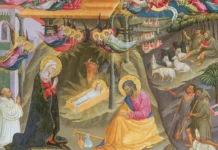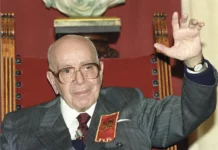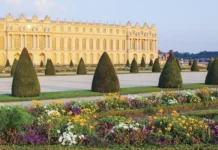The devotion to the Sacred Heart of Jesus was kindled within little Plinio from an early age. He felt especially attracted by the nobility and goodness of the Sacred Heart, as he would later explain.
Iremember with emotion that Our Lady arranged things in such a way that I resided near a church so full of blessings as the Church of the Sacred Heart of Jesus.1 There I attended Sunday Mass with my parents from the earliest times I can remember.
This shrine exercised an effect on me which I now see was a supernatural action; but I imagined that those feelings arose from the visual aspects of the building, whose composition of colours and forms seemed to my eyes so dignified and appropriate that for me it was the expression of sanctity itself.

“Would you like a place here inside?”
It was not difficult for me to perceive that Our Lord Jesus Christ, specifically in making His Heart visible to men, was the infinite source from which all good emanated. In Him were realized all possible perfections and marvels of soul, in a way that I could never have imagined! And as I discerned the good spirit in everything in that church, I thought: “This ambience is a reflection of Him! The harmony I find here is God himself. He is this to a supreme, extraordinary, perfect and infinite degree.”
Sometimes I would stand before the statue of the Sacred Heart of Jesus at a side altar of the church. I saw Him standing very nobly, with a smile that had a slight air of sadness, but immensely inviting, touching His Heart with His hand and looking at those below, as if saying: “Would you like a place here inside? Will you not accept Me? Look, what a treasure! This is for you!”
I looked and thought: “I know it’s a statue and not a man, but the people who built the church want God to be seen like this, and so they represented Our Lord in this way. But God, seen like that, is complete! I realize that He is indeed like this.
“What a physiognomy! The beauty that I hear people speak of is worth nothing! If one day I wanted to analyse the idea of beauty, I would come here to look at His physiognomy, for only He is beautiful! This is the standard: beauty of soul rather than of body. But what a body! And behind it, what a soul! … What a marvel!
“Since this image coincides in an entirely satisfactory manner with the atmosphere of the church and with what I have been taught about Our Lord, by looking at His physiognomy, His hands, His garments, His hair and His demeanour, I will have an overall idea of Him, which I can enhance and perfect if I examine each point – above all His divine eyes and His Sacred Heart.
Our Lord alive, welcoming and affable
I then began to make a psychological analysis of Him and discerned His character. Today I see how much I “archetypified” the statue because of my innocence, for it was in fact far from being what grace made me see. In an attitude of respect and adoration, I composed the highest of ideas that my child’s mind could form. Consequently, when much later I saw the Holy Shroud, I exclaimed, “It is Him!”

I could say that what I saw in childhood represented Our Lord even more faithfully than the Holy Shroud itself, which is easily understood, for the latter depicts Him in death and a victim, while in the image of the Sacred Heart He presented himself to me alive, welcoming and affable. I saw in Him something of an unfathomable goodness, and this idea was enhanced by the impression made on me by the red colour of His Heart.
I was also enchanted by Our Lord’s appearance of cleanliness and good manners, expressed in the form of His face and even more in His body, which seemed to emit light. His tunic gave me the idea of a perpetually immaculate person, without any stain on His soul or His clothes. And there was a discreet golden border on His garment that seemed to me indispensable to His loftiness. Without gold, He would not have revered His own grandeur as He should. His awareness of His own majesty delighted me.
I said to myself: “How He stands with distinction! How the manner of holding the Heart is that of a polite person! How the position of His head is like that of someone who has received a good education! How neatly His beard is arranged, without any pretentiousness! What supreme natural aristocracy in His hair! One has the impression that He does not even think of it, but there is not a curl, nor a strand, that are not entirely in their proper place, to give a perfect idea of himself!
“Many people have lived in surroundings more distinguished than those He frequented. But… true distinction is what He has! The others are all insignificant compared to Him!”
And I came to the conclusion: “How He is a friend of universal order! How coherent He is with that order! He loves all things in their proper order and in the most beautiful aspect they can render of themselves. And with how much affection! He loves this rose which has been placed on His altar, just as He loves me who am also at His feet. He is consonant with all that is upright! The Catholic Church is holy because she is like Him; she is a hyphen between Him and us; she is the very halo that encircles His head, and for this I love her! His influence, His mentality and His presence are in this environment.
These graces were of such profundity and scope that I do not think it was possible, at that age, to have known more about Him than I did.
“Here is Plinio…”
I had the impression that He was looking at me, not with the glass eyes of a lifeless statue, but somehow communicating to that statue a certain expression. I did not know how to define this look, nor did I bother to do so, because, on the other hand, I thought it was perhaps an illusion on my part, in view of the distance between Him and men. How could He ever manifest himself in that way to me?
At any rate, it seemed to me that He was doing with me what I was doing with Him: analysing. And I imagined that He looked at me thinking: “Here is that Plinio, the child number ‘one trillion five hundred million and so on’, whom I like and in whom I am pleased to appreciate these particular good aspects; from whom I expect this particular thing. He is a good child, to whom I deign to look upon with compassion and with the intention of helping him. Since he is here, I have something to tell him, of which he should take advantage.”
I already considered this to be much more than I deserved, and so, faced with His attitude, I reflected: “He is a Shepherd and a King who has undertaken to govern me, and He absolutely wants my docility to His directions. He will give me advice and orders, preparing the way for me to turn to Him.”
I reflected: “First of all, I feel lifted up above myself, for seeing His grandeur. From whence a certain light is shed upon my thoughts and my vision, which makes me ecstatic, because something in me is made to admire that which is greater than I. When I leave my normal occupations as a boy and I see something much greater than myself, I have the impression of fleeing from the good to the excellent! There I stand on my tiptoes and rejoice. That is: I see Him as He is and I adore Him.
“I notice that, as I contemplate Him, He makes me, so to speak, ‘touch with my hands’ His thought, His desires and His feelings. And this communicates to me an uprightness and a holiness in my thought, in my desires and my feelings, like a delicious drink that I take and which pleases me enormously, but which at the same time corrects me. In other words, by adoring Him, I see that my distorted and reprehensible aspects are rectified and, in this way, He heals me of illnesses of whose existence I was unaware.”
Interior words from the Sacred Heart of Jesus
His seriousness impressed me greatly, and I perceived that He wanted to manifest it in the way He held His Heart, surrounded by thorns and with a flame in the centre of which was a cross. This Heart, removed from the breast and exposed, gave me the idea of a certain violence, which was accentuated by the red colour, although it was very beautiful. This reminded me of the Passion that He had suffered, and the impact of these symbols was for me tantamount to a question He was asking me: “Do you realize that in each one of your bad actions you have wounded my Heart? See how good I am. Weigh the evil you have done.”

And I thought: “What intransigence! It is enough to commit a fault for Him to show His wounded Heart… How much purity and wisdom! He is showing what I have done… His hands are wounded, and I have a part in it. His feet, appearing under His garment, are also wounded… My faults have contributed to these wounds. I feel that in me there are unsuppressed potential faults, from which I am still not free, for I have not yet rejected them.
“I am also clearly seeing all that is bad in me… If I do not pay attention to this, I am lost, for I do not know how far I may fall…” And I concluded: “How the things of man touch the infinite! How beautiful life is, considering that every little fact has a relationship with Heaven! How big everything is!”
That was His first “message” to me.
The second, however, was manifested like this: “Nevertheless, my son, I do not say this to you to condemn you, but to forgive you, because there is in Me a wellspring of affection softer than velvet, gentler than any sea breeze and capable of inundating you entirely, to your innermost being.”
And I continued reflecting: “How immense is His sweetness! I would not be able to measure His grandeur if I did not understand the dimension of this sweetness! I feel that He does not wish to demand anything from me, nor to punish me, nor to take revenge by placing His wounded but victorious foot on my foolish and sinful head. No! He wants to tell me that He is ready to pay good for evil, because in spite of everything, He pities me considering my littleness.”
That correction was delightful, but I realized that it would be difficult for me to maintain that interior attitude and that, at a certain moment, I would have to suffer and struggle very much. But as a child, I thought: “Well, the time has not yet come! And this is so good that I will leave that problem for later.” I was more interested in fixing my attention on what God was showing me, than in deducing for myself the future consequences that would result from this.
Desiring the “consecratio mundi”
However, my desire went even further: I wanted to live in Him! And I reflected: “If I could study, pray, converse, in short, do everything that a child does, at the feet of the image of the Sacred Heart of Jesus, it would be for me an explosion of joy, because I feel that He would pervade everything in and around me, including my friends.”

One might think that I wished to remain there praying, abandoning the games, the eating, the nice bed and the comforts. It was not so! My idea was this: “How good it would be if He could preside over my whole life!”
I would like to sneak an éclair in and say to Him, “Lord, here is this treat, so in tune with You. I will unite myself to You by eating it and thinking of You. Bless this éclair!” I would eat it at His feet and be overjoyed! Then I would say: “Lord, I’ve brought another one… It is coffee-flavoured, my favourite kind of éclair!”
And if I couldn’t stay, I would say goodbye to Him like this: “Lord, I thank You for the good company You have been!” And I don’t think there would be anything bad in that. Ultimately, this was the desire for the consecratio mundi and the sacralization of the temporal order.
“The joy of my life”
Today I realize that my attitude at those moments was one of true prayer, though not vocal.
I thought about many things, delighted to see that they were good and relating them implicitly to the Sacred Heart of Jesus, which was, therefore, a deeply religious meditation.
In those hours of silence, I had a very intense peace and contentment in sensing my virtue and my union with Him. And that was the joy of my life! If someone were to claim, with proofs, that the Sacred Heart of Jesus did not exist, I might well have had a convulsion and died. For if He were not true, I would disintegrate and would no longer be myself! ◊
Taken, with slight adaptations,
from: Notas Autobiográficas [Autobiographical Notes].
São Paulo: Retornarei,
2008, v.I, p.502-518
Notes
1 Present-day Shrine of the Sacred Heart of Jesus, located in the Campos Elíseos district in São Paulo.







